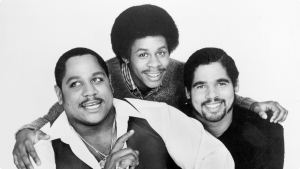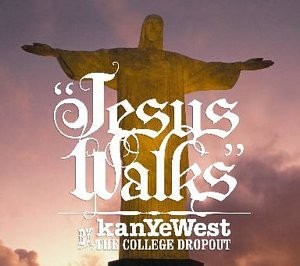By Ross Hoch
 ‘I feel like I’m too busy writing history to read it.’
‘I feel like I’m too busy writing history to read it.’
You’ve heard it before: Modern music is all the same, some formulaic progression of chords, manufactured in the hit factory by calculating writers and producers to hook listeners, before being neatly packaged by some attractive entertainers. Some would say that people who think like this are only reactionaries; old curmudgeons opposed to change, who not only say that music and culture was more diverse in their day, but that they walked uphill both ways to and from the concert hall where they listened to it. However, scientific studies have proved that pop music has a narrower dynamic and timbral range, borrows more heavily from older music, and is less and less unique than ever before. While advocates of the internet age might disagree, for the most part the significant capital needed to professionally produce and distribute music and other forms of entertainment to the mass market encourages an industrialization and streamlining of the process. Cultural theorists like Adorno have gone so far as to suggest that with the advent of the industrial age and mass markets, all of culture has been infected with mind-numbing sameness, devoid of original thought. Adorno even argues that the supposed counterculture movement merely offers the illusion of choice which functions within and perpetuates the existing system of sameness. However, there have been certain artists who seem to have provided strong counterexamples to Adorno’s claims. One of the most notable is Kanye West, who gained fame with his groundbreaking single “Jesus Walks.” While, this work admits that in a world of mass-production the danger of all art being the same exists, Jesus Walks rejects cultural and genre norms, genuinely supporting the idea that the exceptional creativity and individuality of human spirit can overcome industrial society’s pressure for sameness.
Kanye West’s second (and most popular and critically acclaimed) “Jesus Walks” music video. Not the contrast between the flames of the devil that are trying to engulf West at one moment and the halo that surrounds him at the next. Also note the blatant undisguised allusions to racism in America.
Though it was conceived of well after Adorno’s publication of his cultural theories on an inevitable sameness (in 1944) hip hop was in many ways born out of a reaction to the culture industry and “establishment” domination of culture and entertainment. Working class African Americans in the South Bronx, disenchanted with the almost – systematic oppression and a lack of opportunity in spite of recent civil rights movements, and not given a voice in popular “industrialized” artistic forms like rock and roll, created a new unique cultural movement to express themselves. As the Paley Center writes, “From the beginning, hip-hop was aggressive and oppositional, a break from the musical traditions it followed.”[1] In rejecting the primacy of the melody (something previously thought to be a musical necessity) and instrumentals, in favor of the layering of beats with rhythm, rhymes, bass, and samples, hip-hop established itself musically as a unique, and innovative art form, outside of Adorno’s monotonous “culture industry.” Furthermore, by giving a voice to oppressed inner-city blacks and speaking freely about the harsh realities of inner city life it gave expression and agency to those who Adorno would have asserted to be voiceless, brainwashed subjects of the culture industry.

The Sugarhill Gang who had the very first hit rap single “Rapper’s Delight” in 1979.
Yet, few would recognize the 21st century hip-hop culture (that Kanye West wrote in) as the wholly innovative, unique form of expression of a typically marginalized segment of society. As hip-hop spread to the wider world in the 1980s, corporate interests took what had been a subversive and revolutionary form of music made for the oppressed and commoditized it for profit and mass consumption[2]. Under the pressure of corporate-driven profit, rappers have been driven towards defined media stereotypes: such as the “pimp”, “gangsta”, and “playa”, in corporate America’s attempt to profit from narrow, but dramatically appealing definitions of inner-city black life for profit. This evolution in hip hop has led some like music critic Dart Adams to say that hip hop (like one of Adorno’s “countercultures”) merely presents the illusion of choice, existing “almost solely to maintain the status quo and promote moneyed interests.”[3]
Within this context of hip-hop as the product of an industrial process, the unorthodox messages in “Jesus Walks” provide a testament to the fact that despite the conformist pressures of cultural mass production individuals have the capacity to produce art of substance and individual meaning. For instance, Jesus Walks very premise, that of the walk with Christ that everyone must embrace, “Jesus Walks” rejects adopting for himself the conventional “bad-ass” gangster, rapper, and pimp personas and instead chooses to adopt that of a Christian capable of humility. West notes that this is specifically a rejection of the terms and corporate pressures of the producers, in rapping, “So here go my single dog, radio needs this/ They say you can rap about anything except for Jesus./ That means guns, sex, lies, videotape./ But if I talk about God my record won’t get played, huh?” While one might be led to think that the risks of stepping outside convention would be consumer rejection, West explicitly states that he is rebelling against the corporate controlled radio industry (and record industry). Thus he does not believe his innovative artwork to be outside the bounds of consumer tastes, but rather outside of the narrow, negative and monotony-inducing “guns, sex lies, videotape” confines imposed by the radio and record industry. In interviews about the song West often cited that those in the record industry, while admitting the song’s undeniable musical and lyrical excellence, stated that the centrality of the Christian theme meant that it would not get playtime on the radio[4]. Yet, in explicitly challenging the producers and describing the issues with the corporate elements of hip hop, West not only forces the hip hop industry to widen its scope in playing this convention-defying song, but also in observing its success, confront the fact that their limited scope was neither productive in forming good art, nor in catering to true consumer desires.
Furthermore, unlike the hit singles of many of West’s contemporaries, “Jesus Walks” is the rare piece of art that by using old material creates a piece of music that is genuinely innovative. Hip hop production has always been an amalgamation of various musical motifs, beats, samples or songs, with the payoff of the best songs being far more than the sum of their parts. However, in recent years this potentially rich combination has often become more and more formulaic. Rap has evolved in the direction of a more pop-like formula with a base synthesized beat and musical riff overlaid with alternating rap verses and more and more poppy, melodic hooks typically infused with a couple ear-pleasing samples. In contrast to this general trend, “Jesus Walks” utilizes several musical elements rarely used in mainstream hip hop to create a rich, and frankly surprising texture of sound. As Pitchfork (a magazine particularly vicious in its critiques of unoriginality) remarks, “Militaristic drums, choral melisma, snake-charmer keyboards, and swatches of orchestration made “Jesus Walks” an odd thing to spill out car windows in summer 2004.”[5]
In addition to these elements atypical of contemporary hip-hop, “Jesus Walks” makes heavy use of gospel choir, incorporating an element of the African American tradition of music seldom paired with the heavy beat and rhetorical power of mainstream rap to construct a truly moving refrain. Indeed, the song made gospel so central to its musical themes and has motifs so characteristic of gospel that it was even briefly nominated for several gospel awards categories despite the fact that the song was not traditionally considered within the confines of gospel music. (Don’t worry cultural conservatives quickly convinced the awards organization of the need to remove a song so “secular” and “profane” from the nominees).
An early Jesus Walks music video. Listen for the way in which milatiristic drum beats, impassioned gospel solos, the backing children’s choir, and orchestral transitions combine to create a “towering inferno of sound” particularly during the refrain from 1:50-1:20.
Jesus Walks” gradually layers all of the above-mentioned voices from all corners of culture on top of each other to build what the Observer describes as “[a] towering inferno of martial beats, fathoms-deep chain gang backing chants, a defiant children’s choir, gospel wails, and sizzling orchestral breaks.”[6] It is a creation that simultaneously hearkens back and stays true to musical traditions, particularly African American hip hop and gospel, and yet is so removed from the stereotypical formulaic conception of commoditized hip hop or any form of mainstream music, that upon listening one cannot help but question Adorno’s theory of universal cultural sameness.
While we have established that West thoroughly rejects the notions of conventional hip hop in terms of both subject matter and musical composition, “Jesus Walks” could have been a song that while rejecting mainstream elements of the hip hop industry merely embraced other establishment cultural values previously not expressed through hip hop. “Jesus Walks” could have just been some catchy musically brilliant work that presented Christ as a panacea to all the problems facing America, but instead it explores the struggles, false promises and internal conflicts in the American dream for marginalized members of society.
There is no one version of the American dream. It’s a buzzword or buzz phrase, if you will, and to some extent it has a different meaning for everyone. However, there is a sort of establishment portion of the American dream that a Marxist like Adorno would say the ruling classes foist upon you. This is that success is possible through hard-work within the confines and conventions of what’s accepted by society. In other words if you adopt the Protestant work ethic as a guideline in your personal and work life some sort of success will come, regardless of your background. Of course this implies the drug-dealers and criminals are that way because they are less worthy. They had a chance to better themselves and wasted it. They are criminals chiefly because they are morally depraved and corrupted.
West disagrees with this empirically flawed premise and presents them drug dealers and criminals as equals, morally complex victims of unjust circumstances and stereotypes, to be valued as much as anyone else, through the use of various speakers on either side of the conflict. In the first portion of the first verse he raps, “You know what the Midwest is?/ Young and restless/ Where restless (niggas) might snatch you necklace/ And next these (niggas) might jack your Lexus.” Here he reveals the racial stereotypes of thievery, depravity, and the inferior quality denoted by the usage of the n-word, that are projected onto poor blacks by American society. West uses and identifies with (using “we”) further examples of the systemic environment into which blacks are thrust such as arrested by police and tried in court solely as a result of skin color so that his audience may sympathize with those “who walk the valley where the shadow of the Chi where death is” like they would with the shepherd of the 23rd psalm. He builds on the sympathy he has established in the listener for the difficulties of the marginalized by segueing into a first-person narration, spoken by a drug dealer raised in this environment. Finally, after hearing of the repeated oppression and denial of the American dream in America we can understand why the speaker no longer believes in Jesus’ ability to save us.” Through presenting the victims such as the drug dealer and the “victims of welfare” as torn between the devil and God, Kanye outlines the duality of man and the members of an unequal American society constantly torn, “at war” with “terrorism” “racism,” and “ourselves.”
A product of the culture industry would likely have accepted and propagated the inequality-enforcing (interpellative) message of the elites American Dream. In contrast, West outlines the inherent flaws and inequality caused by racism and stereotypes ingrained within American society, and in doing so creates a genuinely individual, complex, and original message, devoted to a cause greater than profit or maintenance of the establishment. Through presenting victims such as the drug dealer and the “victims of welfare” as torn between the devil and God, Kanye outlines the duality of man and the members of an American society constantly torn, “at war” with “racism,” “terrorism” and “ourselves”.
In its refusal to conform to norms of popular music genres, and its complex voicing of the struggles of marginalized African-Americans in society “Jesus Walks” revives the dissident, nonconformist, nature which made hip hop so powerful and attractive at its inception. Moreover, “Jesus Walks” is nothing if not a musical masterpiece created through a rarely seen combination of gospel, rap, orchestral arrangements, and carefully chosen samples. In “Jesus Walks” West created a mass-produced cultural work of rebellion and originality that is a joy to listen to in its own right. Thus, many pieces of entertainment lead their audiences to absorb the conformist ruling-class ideologies packaged within them “Jesus Walks” demonstrates the potential for certain mass-produced entertainment to elevate its audience’s mindfulness.
“Jesus Walks” openly acknowledges and attacks the perceived culture industry (in this case specifically the record industry) and its tendency to churn out art that is topically and musically monotonous and disconnected from the realities of social conditions within American society just as Adorno does. However, by attacking and rebelling against the same cultural problems Adorno diagnoses, it disproves Adorno’s claim that all art is the same, for in order for a mass-produced piece of art to genuinely attack the culture industry for its “Adornian” monotony and false messages, it must be different from those messages which it critiques. The beauty of “Jesus Walks” as an artifact of cultural individualism and authentic originality is that it works within Adorno’s own framework for culture but provides a counterexample to its central claim, that in a culture of mass production all culture is essentially the same.

References
[1] Calhoun, Claudia. “The Emergence of Hip Hop.” Paley Center. N.p., n.d. Web. 16 Mar. 2016. <https://www.paleycenter.org/the-emergence-of-hip-hop>.
[2] Romero, James. “Influence of Hip Hop Resonates Worldwide.” LA Times 14 Mar. 1997, Column One: n.pag. LA Times. Web. 16 Mar. 2016.
[3] Adams, Dart. “Hip Hop Turns 40.” NPR. NPR News Organization, 11 Aug. 2013. Web. 16 Mar. 2016.
[4] Leung, Rebecca. “Rocking for Christ: Christian Music Becoming Big Hits on Mainstream Radio Stations.” CBS News. CBS Interactive, 1 Dec. 2004. Web. 17 Mar. 2016.
[5] Leung, Rebecca. “Rocking for Christ: Christian Music Becoming Big Hits on Mainstream Radio Stations.” CBS News. CBS Interactive, 1 Dec. 2004. Web. 17 Mar. 2016.
[6] The Guardian Observer. Web. 18 Mar. 2016. Mulholland, Gary. “Song of the Month: Jesus Walks by Kanye West.” The Observer 15 Aug. 2004: n. Pag.
Key Works
Adorno, Theodor, and Max Horkheimer. Dialectic of Enlightenment. N.p.: n.p., 1944. Print.
“Jesus Walks.” Comp. Kanye West and Che Smith. College Dropout. Perf. and prod. Kanye West. Roc a Fella, Def Jam, 2004. CD.
